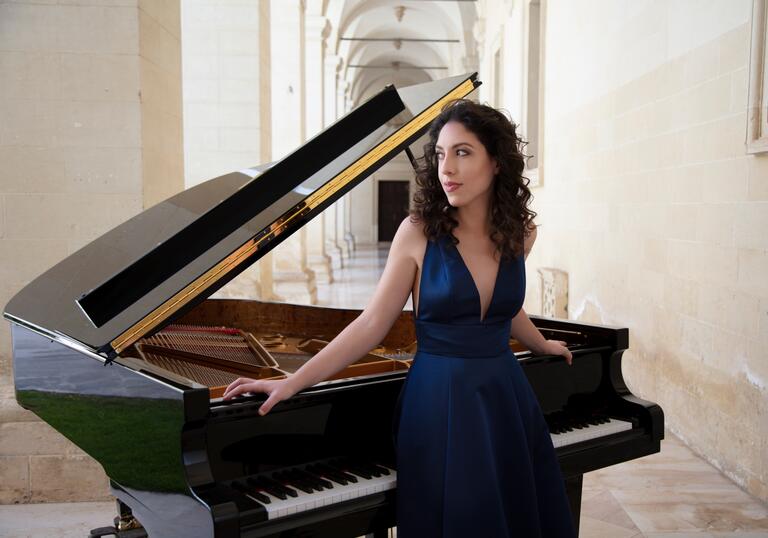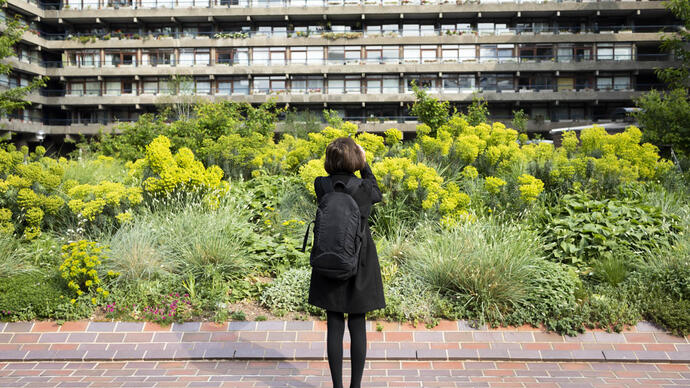
Programme and performers
Alexander Scriabin Fantasie in B minor
Mario Castelnuovo-Tedesco Cipressi
Claude Debussy Prélude Book 2 No 7, La terrasse des audiences du clair de lune
Prélude Book 1 No 7, Ce qu’a vu le vent d’ouest
L’isle joyeuse
Franz Liszt Piano Sonata in B minor
Beatrice Rana piano
Beatrice Rana
Beatrice Rana has rapidly gained admiration from conductors, critics and audiences internationally.
She performs at the world’s most esteemed concert halls, including the Berlin Philharmonie, Amsterdam Concertgebouw, Carnegie Hall and Lincoln Center, New York, Wigmore Hall, Royal Albert Hall and Royal Festival Hall here in London, Philharmonie de Paris, Théâtre des Champs-Élysées, Vienna’s Konzerthaus and Musikverein, KKL Lucerne, Cologne Philharmonie, Munich’s Gasteig, Prinzregententheater and Herkulessaal, Frankfurt’s Alte Oper, Hamburg’s Elbphilharmonie and Laeiszhalle, Liederhalle Stuttgart, Zurich Tonhalle and Philharmonie de Luxembourg.
She collaborates with conductors such as Yannick Nézet-Séguin, Jaap van Zweden, Sir Antonio Pappano, Manfred Honeck, Klaus Mäkelä, Gianandrea Noseda, Fabio Luisi, Riccardo Chailly, Paavo Järvi, Valery Gergiev, Yuri Temirkanov, Vladimir Jurowski, Gustavo Gimeno, Lahav Shani, Jakub Hrůša, Dima Slobodeniouk, James Gaffigan, Mirga Gražinytė-Tyla, Gustavo Gimeno, Susanna Mälkki and Zubin Mehta.
She has appeared as a soloist with many leading orchestras, including the Royal Concertgebouw Orchestra, the Helsinki, London, Los Angeles, Luxembourg, Munich, New York, Royal Liverpool, Royal Stockholm, St Petersburg and Seoul Philharmonic orchestras, the Antwerp, Bavarian Radio, Boston, BBC, Chicago, City of Birmingham, Dallas, Danish National, Detroit, London, Lucerne, Melbourne, NHK, Pittsburgh, San Francisco, Toronto and Vienna Symphony orchestras, Chamber Orchestra of Europe, Orchestre de Paris, Philadelphia Orchestra, National Symphony Orchestra, Washington DC, Orchestre National de France, Orchestra dell’ Accademia Nazionale di Santa Cecilia, Orchestra Sinfonica della RAI, Filarmonica della Scala, Amsterdam Sinfonietta and Tonkünstler Orchester.
This season she tours in Europe with the Chamber Orchestra of Europe and Sir Antonio Pappano, Academy of St Martin in the Fields and the Luxembourg Philharmonic Orchestra, as well as making debuts with the Berlin Philharmonic with Yannick Nézet- Séguin and the Cleveland Orchestra with Lahav Shani and returning to the New York Philharmonic with Manfred Honeck.
Beatrice Rana records exclusively for Warner Classics. Her first album, released in 2015, received international acclaim, including BBC Music Magazine’s Newcomer of the Year Award. Two years later she released Bach’s Goldberg Variations, winning Gramophone’s Young Artist of the Year, Discovery of the Year at the Edison Awards and a Classic BRIT. Since then she has recorded works by Bernstein, Chopin, Ravel and Stravinsky and, most recently, concertos by Robert and Clara Schumann.
In 2017 she started her own chamber music festival, Classiche Forme, in her home town of Lecce, Puglia. The festival has become one of Italy’s major summer events. She also became artistic director of the Orchestra Filarmonica di Benevento in 2020.
She was born into a musical family, made her concerto debut aged 9, and won Second Prize and the Audience Award at the 2013 Van Cliburn Competition.

Our Patrons and supporters
Find out about our Patrons, who help us keep our programme accessible to everyone and allow us to continue investing in the artists and communities we work with.
Love the arts? Become a Patron to engage more closely with our programme.

Who we are
Meet our management team, our Board and the Trustees of our charitable arm, Barbican Centre Trust.
